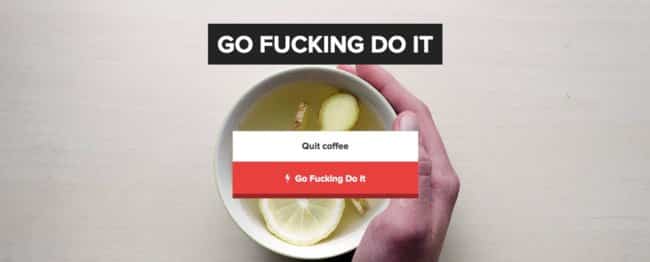Two years ago, I decided to change my sleeping habits. I spent the majority of my high school and college years staying up until five in the morning. I’d then sleep in as late as I possibly could, guzzling coffee into the wee hours of the night and regularly proclaiming my hatred for the early morning.
Then, when I hit my twenties, began freelancing, and moved in with roommates who had vastly different schedules and weren’t very good at staying quiet in the morning, everything changed. I found myself woken up bright and early most days when my roommates crashed around the house to get ready for their 9-5 jobs.
With a wake-up call like that, I’d spend most of my day in a terrible mood, and that grumpiness would last well into the evening. By then, I would finally muster the motivation to write, but would often be too tired to get anything substantial done. My writing career suffered, my health suffered, and my mood suffered…and I still hated mornings.
Something had to change.
So, I took the leap and decided to become a “morning person”. I figured that if I got up at 5:00AM, well before anyone in the house would be awake, I’d have the energy, time, and peace to start advancing with my writing goals.
Easier said than done, am I right?
Maybe you have a habit that you’d like to get rid of. Maybe it’s an addiction to sugar or soda or caffeine. Maybe it’s playing video games when you should be studying. Or maybe it’s watching Netflix when you should be going to the gym.
The great news is that, no matter how deeply our habits are embedded in us, we still have the power to fix them. It’s not easy, but it is possible. Change begins with understanding how habits work. What is a habit? How is it formed? What motivates us to stick with unhealthy behaviors? These are important questions that we have to answer before we can create effective strategies to break bad habits.
Wondering how to build good habits? Read this next.
How Habits Work

In his book The Power of Habit, Charles Duhigg defines a habit as “an ingrained pattern of behavior”. According to Duhigg, habits have three stages:
- The cue
- The routine
- The reward
The cue is the thing that triggers the habit in your mind. If you’re addicted to caffeine, it could be something as small as simply waking up in the morning and walking out to your coffee pot. Or, it’s the splitting headache you get when you’ve missed your daily dose. If it’s playing video games instead of studying, the cue could be the resistance you feel to actually opening your textbook and doing homework.
The routine is simply the action of the habit, like slamming a RedBull, powering up your console or PC and playing hours of Fallout, or kicking off your shoes and sitting down on the couch to watch episodes of Star Trek on Netflix.
The reward is just that: the reward for your behavior.
The Biology of Bad Habits

In more long-term, permanently ingrained habits, there is also the craving. This craving happens after your brain has experienced a powerful reward for a habit, like the caffeine hit from a cup of coffee. Your amygdala (the part of your brain associated with memory and emotion) files away the memory of that reward together with the good emotions associated with it.
Once the cue is triggered in your mind, your brain then associates that cue with the happy emotions, and starts pumping out dopamine in anticipation of the reward it’s going to eventually receive.
Dopamine acts as a lense, focusing your brain on one thing, and one thing only: the reward, and how to get it. Maybe you walk by the coffee shop and smell the coffee wafting through the door. That acts as a cue, and your brain then begins anticipating that coffee before you even get ahold of it, making you walk into the door and order a drink before you even have time to think about what you’re doing.
It’s also essential to understand: every habit has a reward, otherwise you wouldn’t do it.
What’s a bad habit, then?
A bad habit is any routine that hinders you from your personal or professional goals, rather than helping you toward them. Usually, these bad habits have short-term rewards at the expense of your health, happiness, or productivity. The Greeks actually had a term for this self-destructive behavior: Akrasia.
How to Break Bad Habits: 5 Strategies That Work

The good news is that, thanks to modern psychology and old wisdom, you have a lot of tools at your disposal to combat and replace bad habits. Here are five strategies you can use to banish bad habits for good:
1. Develop a Tangible Reason
The first key to breaking a bad habit is to visualize a tangible reason for why you want to break that habit in the first place. If you don’t know why you want to stop a bad habit, then chances are you won’t ever begin to change.
For me, it was the numbers in my bank account. I wasn’t getting as much writing done, and so consequently my business wasn’t generating as much money as I would like. I knew that the whole reason I wasn’t being productive was due to my sleeping habits, so it gave me a tangible reason to wake up early in the morning and start getting things done right away.
Beyond that, I also wanted to be happier throughout my day. I knew that if I got up early and had some time to myself to wake up and plan my day on my own terms, I’d be in a much better mood throughout the rest of the day. That turned out to be an even more powerful motivator than the money.
So, figure out what works for you. If you’re in school and you’re trying to stop procrastinating, maybe your grades are a big enough motivator. Or, perhaps you’d like to stop procrastinating so that you have the time to do things you actually want to do, guilt-free. Just make sure that it’s a strong enough and tangible enough incentive that you’ll be willing to change, and you’ll be well on your way to breaking that bad habit for good.
2. Replace the Routine
“The Golden Rule of Habit Change: You can’t extinguish a bad habit, you can only change it.” – Charles Duhigg
It’s next to impossible to truly break a bad habit altogether. Rather, like Charles Duhigg says, it’s much easier to replace that bad habit with a different, healthier habit that has a similar payoff. For instance, my roommate was trying to cut back on her soda intake. She figured out that what she was craving from that soda wasn’t actually the sugar or caffeine, but simply the taste and sensation of a carbonated drink.
So, she decided to replace the sodas she’d normally be drinking with La Croix. While she didn’t stop drinking soda altogether, she was able to combat her craving by choosing to replace soda with a healthier but similar beverage.
With this strategy, the cue and reward part of the habit loop are the same, but the routine is different.
I did a similar thing a while back when I found myself watching Netflix and YouTube videos over breakfast. It was a terrible habit that ate my entire morning and led to me being far less productive than I could have been. What I really got out of that habit was enough mental stimulation (something interesting, like a YouTube video), and enough noise to wake me up in the morning and put me in a good mood.
So, I replaced those Netflix and YouTube binges with podcasts. The podcasts were a great option because there was a limited amount of content available (as long as I was up-to-date on that particular podcast), so I would just listen to the latest episode to get my brain active during the morning. Then, once it was over, I moved on with my day.
Both of these examples rely on a third strategy for breaking bad habits: knowing what you’re really craving.
3. Figure Out What Reward You’re Really Craving

Sometimes, the primary reward for your bad habit isn’t obvious, and you have to dig deeper to figure out what makes you tick.
Charles Duhigg had a bad habit where, every day at work, he’d get up and buy a cookie. He knew it wasn’t good for him, and he wanted to change his habit. So, he sat down and tried to figure out why he wanted that cookie:
- Was he craving the sugar because it was late in the afternoon?
- Did he want an excuse to leave his desk?
- Was it simply because the cookie tasted good?
- What motivated him to leave his desk to get that snack?
As it turned out, he figured out that getting up every afternoon to get that cookie gave him the excuse to go and socialize with his coworkers. That was the real reward, not the cookie itself.
It’s like Socrates said: Know thyself. Figure out what reward you’re really looking for, and then figure out how to replace it with a different, healthier behavior.
4. Pre-Commit to Change (Make Your Life Easier)
“This is how willpower becomes a habit: by choosing a certain behavior ahead of time, and then following that routine when an inflection point arrives.” – Charles Duhigg
Another essential step you need to take when breaking a bad habit is to remove as much access to that bad habit as you possibly can. As a rule, the more steps you have to take before you can get that reward you’re craving, the less likely you are to actually go through with the entire habit loop.
Think of it this way: the current you is much smarter than the future you. The current you has pre-committed that you’re not going to sit down and play video games the moment you get home from class. Instead, you’re going to go running. So, you put away your game console, with the controllers and cords (or set your PC up so that you have to log out of one user and log into another user to access your games).
That way, it’s much easier for future you to resist that craving. In order to satisfy that craving, future you will have to take out the game console, hook it up to the TV, hook up the controllers, and boot up the game…and that’s a lot of work! This interrupts the habit loop, making it easier for your brain to choose the better option.
5. Embark on a 30-Day Challenge
If all else fails, you have one big gun at your disposal: a 30-day challenge.
You can do just about anything for 30-days. Coincidentally, 30-days is enough time to begin re-patterning your behaviors. The best way to complete one is to get someone else involved. Find someone who’s invested in your success, and make them a deal: if you fail your 30-day-challenge, then you owe them $100, or sushi, or pretty much anything else that will hurt your wallet or your pride enough to motivate you not to fail. Have them check up with you every single day.
By the end of it, you’ll either be short $100, or you’ll have made significant progress on breaking your bad habit.
If you want some technological help implementing a 30-day challenge, then we have two suggestions: Beeminder and Go Fucking Do It.
App #1: Beeminder

One great way to implement the 30-Day Challenge is through Beeminder. Beeminder is a goal-tracking app with a twist: if you don’t reach your goals, the app will take your money.
Ouch.
How it works:
- Set a quantifiable goal in the Beeminder app.
- Commit to an amount you’re willing to pay if you get off-track.
- The app will then text you every day to ask how you did on reaching that goal. You simply text in your data, and the app graphs it for you. It’s a great way to get that extra oomph of accountability that you need in order to reach your goals or break bad habits.
App #2: Go Fucking Do It

If you’d rather be monitored by a person, and want to set up a tangible 30-day Challenge Contract, you can use the Go Fucking Do It app. Here’s how it works:
- Give the app a goal.
- Pledge some money that you have to pay if you don’t hit that goal.
- Type in the email of your “supervisor” – a friend who will check up on your progress.
- The app can then ask your supervisor whether or not you met that goal. If they say you did, then it’s all good. If they say you didn’t, then the app will take your pledge money.
There are a couple of caveats to the Go Fucking Do It app:
- Just like a normal 30-day challenge, this app only really works if you have an honest supervisor who’s invested in your success.
- Your pledge money goes straight to the app, not your supervisor.
This is a great item to have in your habit-breaking toolbox, provided that:
- You know someone truly invested in your success.
- The threat of paying a large amount to money to a random app is enough to motivate you to succeed.
Want even more apps to help change your habits? Check out our guide to the 10 best habit tracking apps.
Start Changing Your Habits Today
“There’s nothing you can’t do if you get the habits right.” – Charles Duhigg
Let’s recap: a habit is an ingrained pattern of behavior that starts with a cue that triggers a routine that leads to a reward. Sometimes, there’s a craving involved.
Habits can rarely be stopped altogether. However, there are several steps you can take to replace or repattern your habit into something that helps, rather than hinders you:
- Start by figuring out why you want to change.
- Identify your reward and try and replace your habit with a similar routine.
- Remove as much access to that habit as possible.
- If you’re still having trouble kicking the habit, try starting with a 30-day accountability challenge.
Once you understand how habits work, and know what triggers your own bad habits, you’ll be unstoppable. Trust me, take it from someone who thought they were an incurable night owl. If I can do it, you can do it too! All you have to do is start.
Image Credits: featured, coffee cups, bowl of macaroons, comfy bed

